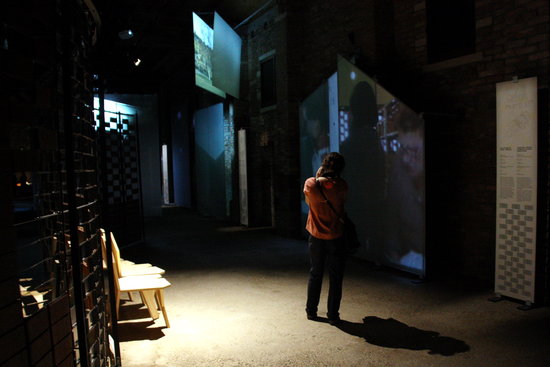Architecture comes to life at the Catalan pavilion in the Venice Biennale
The Catalan pavilion at the Venice Architecture ‘Biennale’ brings architecture to life with the project ‘Aftermath_Catalonia in Venice. Architecture beyond architects’. This project, set to represent Catalonia, is curated by film director Isaki Lacuesta and architects Jaume Prat and Jelena Prokopljevic. The three propose to open a dialogue between architecture and cinema; according to Prokopljevic, the aim is to “teach architecture from the point of view of the user, with buildings that are in use, and to flee from the moment when architects show the buildings when they are just finished and about to be opened, when they are all clean and have no life”.

Barcelona (CNA).- Architecture comes to life in the Catalan pavilion at the art event of the Venice Architecture ‘Biennale’ with the project ‘Aftermath_Catalonia in Venice. Architecture beyond architects’. The project, which represents Catalonia at the collateral event of the ‘Biennale’, opened this Thursday. The ‘Aftermath_Catalonia’ event is curated by film director Isaki Lacuesta and architects Jaume Prat and Jelena Prokopljevic, and created to propose a dialogue between architecture and cinema. In statements to CNA, Jelena Prokopljevic explained that she wanted to “teach architecture from the point of view of the user, with buildings that are in use, and to flee from the moment when architects show the buildings when they are just finished and about to be opened, when they are all clean and have no life”. This will be done through audiovisual installations that aim to show seven different spaces shown in their everyday uses by focusing on the people that are within the buildings and the environments that surround them. ‘Aftermath_Catalonia in Venice. Architecture beyond architects’ is the third participation of the Institut Ramon Llull (IRL, an organisation dedicated to promoting Catalan language and culture internationally) in similar ‘Biennale’ events in Venice.
The project ‘Aftermath_Catalonia in Venice. Architecture beyond architects’, which represents Catalonia at the collateral event of the fifteenth edition of the International Architecture ‘Biennale’ of Venice, opened its doors on Thursday. ‘Aftermath_Catalonia in Venice’ proposes a dialogue between the language of architecture and film, proposing to unify these two disciplines in an installation that creates narratives exchanged between the projects selected through visual connections, sound, materials and concepts.
The Catalan pavilion highlights seven public architectural projects and their everyday use, as shown by the people in them and the environment around them. This approach is to show visitors how the architectural space enables the user to enjoy public spaces as a conscious member of society. It also has two special collaborations: the ‘Taulacreu’ table by Pere Buil and Toni Riba, and the ‘Biennale’ chair by Josep Ferrando. Among the selected installations are a hospital, a park, a theatre and a nature area, among others.
Approaching architecture from the perspective of the user
The project focuses on the relationship between the works of Catalan architecture, explained through their daily use of their environment in terms of a root context, along with the structure of its land and how it improves people’s quality of life by what it brings to the community. The exhibition aims to approach architecture from the perspective of the user, because its intention is to promote an empathic experience leading the observer to perceive and analyse the architecture. The purpose of the project is to stimulate the public’s reaction and to give reasons for reflection. The exhibition seeks to engage visitors, by focusing on the sensory art of the installation. It aims to do so through the projection of the works over several translucent, vitreous surfaces that reflect the complexity of the interactions between people, architecture and the urban or natural landscape.
The works collected in the audiovisual installations are public projects from Catalan architects who carried out their work or began their career in the toughest period of the economic crisis, a time when some needs became more relevant than others, along with other ways of relating to sensitive architectural strategies with daily use, the people and the environment. Among the seven Catalan architectural studies selected for the ‘Biennale’ this year are a wide variety of subjects, including the environmental recovery of the Catalan Llobregat River and Júlia Tower (i.e. the sheltered housing for the elderly), among others.
A participatory and reflective visitor
The film reels for ‘Aftermath_Catalonia in Venice’ will be shown in a space where images seem to float, giving the whole experience a certain ghost-like feeling that unfolds before the viewer, since the space has equipment that retains the image and minimises reflections. In addition, other elements in the exhibition are complementary to the experience and participate in the creation of routes and reflexes to completely obscure the surroundings, leaving only that which is illuminated by the light of projectors and some gradual ambient light, focused on giving information on the project.
How was the project selected?
The project, presented by the Institut Ramon Llull (IRL, an organisation dedicated to promoting Catalan language and culture internationally) was first chosen from a public contest, and then selected by an independent jury, chaired by architect Carme Pinos. ‘Aftermath_Catalonia in Venice. Architecture beyond architects’ is the third participation of the IRL in the section of the parallel events of the International Architecture Exhibition of the Venice ‘Biennale’, which comes after its fourth participation in a similar event dedicated to art alone, the International Art Exhibition the Venice ‘Biennale’.